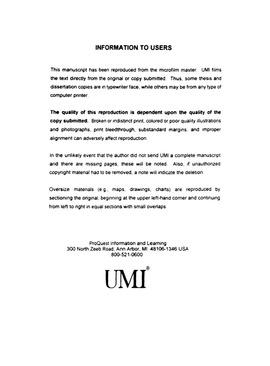| dc.contributor.advisor | Pope, Myron, | en_US |
| dc.contributor.author | Mcpherson, Kevin Antonio. | en_US |
| dc.date.accessioned | 2013-08-16T12:18:48Z | |
| dc.date.available | 2013-08-16T12:18:48Z | |
| dc.date.issued | 2002 | en_US |
| dc.identifier.uri | https://hdl.handle.net/11244/529 | |
| dc.description.abstract | The primary questions addressed by this study are: (1) What are the stories of university presidents of four-year institutions in Oklahoma who transitioned to the presidency from an elected or politically appointed office? (2) Do these stories constitute a way of operating that can be characterized as reflecting a particular leadership style? | en_US |
| dc.description.abstract | Researchers concerned with academic governance have models to assist in understanding college and university's complex decision processes. The usual models are the collegial model, the bureaucratic model, and the political model. Each model calls for a different leadership style. If the collegial model is being used, the president seeks to persuade people by appealing to reason. The president is considered to be "first among equals" in an organization run by professional experts. In this model, the role of the president is not to command or to lead, but to listen to "the equals, " to facilitate and to negotiate. If the bureaucratic model is being used, the president is considered to be a hero who stands at the top of a complex pyramid of power. The hero's job is to assess problems, propose alternatives, and make rational choices. If the political model is being used, the president is a mediator or negotiator between power blocs and must play a political role by pulling coalitions together to fight for desired changes (Baldridge, Curtis, Ecker, & Riley, 1991). Over the years, there has been a transition in the higher education environment from the collegial model to the bureaucratic model, and more recently, to the political model of governance. This study will look at the leadership in the context of these three models of governance and more specifically, how political presidents may reflect a particular leadership style. | en_US |
| dc.format.extent | xi, 163 leaves ; | en_US |
| dc.subject | Education, Higher. | en_US |
| dc.subject | College presidents Oklahoma. | en_US |
| dc.subject | Education, Administration. | en_US |
| dc.title | Political presidents at four-year institutions of higher education in Oklahoma: A study of leadership. | en_US |
| dc.type | Thesis | en_US |
| dc.thesis.degree | Ph.D. | en_US |
| dc.thesis.degreeDiscipline | Department of Educational Leadership and Policy Studies | en_US |
| dc.note | Major Professor: Myron Pope. | en_US |
| dc.note | Source: Dissertation Abstracts International, Volume: 63-11, Section: A, page: 3877. | en_US |
| ou.identifier | (UMI)AAI3070634 | en_US |
| ou.group | Jeannine Rainbolt College of Education::Department of Educational Leadership and Policy Studies | |
